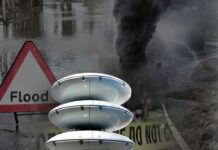
By Rachel Becker, The Verge
When Emirates flight EK 203 from Dubai landed in New York with sick people on board on Wednesday morning, public health officials and local authorities were waiting for it.
Passengers and crew had fallen ill with coughs, fevers, and stomach problems, and 11 people were taken to the hospital.
The scare raised some key questions: when you’re in a metal tube hurtling through the air, how do you get help if you get sick? And what happens once you land?
(A plane with at least 10 sick passengers on board was placed under quarantine at JFK Airport Wednesday. Courtesy of CBS News and YouTube. Posted on Sep 5, 2018.)
The 549 people on flight EK 203 found out on Wednesday when officials evaluated them and took their temperatures.
By early Wednesday afternoon, everyone was allowed to go except for the 11 who went to the hospital, according to the Centers for Disease Control and Prevention.
For now, the cause is still a mystery, but symptoms suggest the flu, Eric Phillips, the press secretary for New York City mayor Bill De Blasio tweeted.
“THE CAUSE IS STILL A MYSTERY”
The CDC is still investigating.
Like a mosquito that spreads malaria, a plane can be a disease vector, too.

“It transmits people with illness from one part of the world to another part of the world,” says Allen Parmet, a former flight surgeon with the US Air Force who teaches at the USC Aviation Safety and Security Program at USC and works as an aerospace medicine consultant.
Still, this kind of thing isn’t exactly new.
People have been traveling across the world for millennia, bringing smallpox to the Americas or spreading the plague across Europe.
What’s different now, Parmet says, is the speed.
Airplanes have sped up the whole process, sparking fears of contagion sensationalized by television and creating unique challenges for treating and monitoring outbreaks.
“It’s not a flying hospital; it’s a bus,” he says.
The Verge spoke with Parmet about how infections spread on planes, what happens when passengers fall sick, and how to investigate an in-flight outbreak.
This interview has been edited for clarity and brevity.
It feels like every flight I’ve been on, there’s been someone coughing. How common is it?
If you take a population of passengers on any given day, somebody’s sick.

They have a cold or respiratory infection, they have allergies.
So it wouldn’t be unusual. And the other aspect is that the humidity of an airplane in flight is very low. And we like at least 40 percent humidity to be comfortable.
Less than that, your eyes get dry and irritated, particularly if you wear contact lenses, your throat gets dry.
So it’s actually pretty common to have somebody coughing in a plane.
There are some allergens in the airplane as well.
It’s very common to get people with cat allergies irritated. Because if you have a cat, your cat owns you, they rub you, they mark you with their dander, and their dander is quite allergenic.
That’s actually a very, very common allergen in the airplane.
How well does infection spread on a plane?
The answer is not very. It’s very dry, which will kill sensitive bacteria like Legionnaires’ disease. It dries out and dies.
Others will go into their hibernation state. It’s hard to spread bacteria in such a dry environment.
Viruses have to travel on droplets when you cough or sneeze.
First of all, the droplets begin to evaporate.
Secondly, they’re subject to the airflow, and the airflow inside an airplane is phenomenally fast, and it goes from the ceiling to floor virtually in all these modern aircraft very quickly, and it stays right where you’re are.
(A dozen passengers on two American Airlines flights from Europe to Philadelphia reported flu-like symptoms upon arrival Thursday, prompting airport officials to notify the Centers for Disease Control and Prevention and other authorities. Courtesy of USA TODAY and YouTube. Posted on Sep 7, 2018.)
At what point do symptoms like coughing become alarming?
That’s a difficult question to answer because we don’t have health inspectors looking at the airplanes.
Now if you go to an international port in a country like Namibia, as you walk through customs, they’re going to scan you with a thermal scanner to see if you’re running a fever.
I was just down in southern Africa, and every port in Namibia, South Africa, Botswana, you went through a thermal scanner because there’s an Ebola outbreak in Congo.
Do we see people who are actively coughing? Producing sputum, bloody sputum? Not looking very good?
That’s where we really have to rely on the people at the desk to look at somebody.
I used to be the medical director for Trans World Airlines, and occasionally, we’d get a customer service agent call me and say, “I’ve got a passenger here, but they really look sick.”
You could conference in and look at them.
I’ve denied boarding to a passenger who I thought had an active disease. He died the next day.
(Nigeria determined to prevent repeat of 2014 Ebola outbreak. Port health officials are prominent, with thermal scanners and quarantine facilities in place at all major airports. Courtesy of CGTN America and YouTube. Posted on May 23, 2018.)
What sort of medical care is available to passengers? What are the flight attendants trained for?
All the flight attendants have CPR training, and they are trained in what is in our medical kits. And basically everybody’s got a two-stage medical kit.
There’s little first aid kit — Band-Aids, some dressings, blood pressure cuff.
There’s a second medical kit [that can only be used by a licensed health care provider] that has some limited drugs and an AED [automated external defibrillator].
The flight attendants are trained to use an AED. We can’t put narcotics on an airplane because then how do we control them? How do we know who’s going to use them?
When it’s beyond what the flight attendants can handle, they’ll call a consultant in-flight — either to MedAire or to the University of Pittsburgh — and ask for advice.
Or they’ll call, “Is there a doctor in the house?” You’ll almost always have somebody with some medical skillset.
““IS THERE A DOCTOR IN THE HOUSE?””
(When you fly in an airplane, do you feel terrible? Seeker did some digging to figure out why this happens! Courtesy of Seeker and YouTube. Posted on Nov 27, 2014.)
Then what?
Let’s say there’s a medical person on board who’s qualified and says, “Okay, this group of people has some sort of infectious disease.”
“I don’t know what it is. They look sick, it’s all infectious.” They would notify the captain.
The next question would be: is this an imminent threat to the health of those individuals?
In other words, do we need to land right now at the nearest airport?
And they’d make that recommendation to the captain, who would almost always take whatever the recommendation is.
If you’re going to declare a medical emergency, which they almost certainly would, they would notify air traffic control.
Air traffic control would route you to the nearest appropriate airport. The airport would then notify their emergency services.
If it’s an infectious condition they would probably notify the public health authorities and the hospital, and you’d start to make decisions about whether those people are dangerous to themselves or are they potentially infecting other people.
Because once you land and the airflow system is turned off, there’s potential for other people to get infected.
So, how serious is this? Do we isolate that group, that compartment?
Oftentimes, you’re constrained about whether people want to stay and be evaluated or do they want to get off the airplane?
I’ve seen people say, “I’ll take my chances, I’m going.” And unless you have a major threat like Ebola, you’d be kind of limited in being able to compel anybody to undergo medical screening or even quarantine.
A row of ambulances #EK203 pic.twitter.com/iXn1bbjmad
— Larry Coben (@LarryCoben) September 5, 2018
Why?
There are legal limits as to what you can do to people.
If you have a disease that’s internationally reportable like Ebola, you have some authority to restrict them.
But if it’s measles, which is a reportable disease, you can’t quarantine people for measles.
You can’t arrest them, you’d have to get some sort of compulsion to do that.
Even with Ebola, when we were bringing some people back from Africa, with the West Africa outbreak, there was a lot of criticism for isolating and quarantining just the individuals who were potentially exposed.
They’d already been assessed and were very low risk.
What happens once the plane has landed?
We’ll try to isolate the sick people, and those folks would go off into medical care, which might include isolation.
That’s not quarantine, but all hospitals have isolation areas where airflow is sucked into the room where the patient is and then out through a filter so that any coughing and sneezing doesn’t get blown into the ventilation system and spread throughout the hospital.
And then anyone who goes into contact them is wearing a glove, mask, personal protective gear.
They look like they do on TV. And that protects other health care workers from contracting disease.
(As the second American infected with Ebola returned to the U.S. for treatment, get an inside look at the CDC isolation rooms meant to keep us safe. Courtesy of NBC News and YouTube. Posted on Aug 6, 2014.)
What would you be asking if a bunch of people on a plane started coughing and reporting fevers?
As a physician, I’m going to say “Okay, a whole bunch of fevers: this is an evolving group illness.”
Because fevers don’t just occur just because I infected you when you got in the door.
Infectious diseases take some time to evolve. Typically, that’s two to three days on the minimum side, for rapid-acting diseases like flu, and MERS [Middle East Respiratory Syndrome].
Measles, you’re talking 10 days.
Airborne diseases are a concern.
So we’d look at where they’re coming from. If we’ve got a group of people, are they all related? What did they do in common?
Because now we’re talking about the way we do detective work in preventive medicine.
Did they have a common exposure to some chemical? To some infectious disease?
Were they all on the trip together? Were they all sitting in the same waiting room for 12 hours, waiting for the plane to take off?
What’s the worst possible airplane sickness scenario?
Our nightmare is somebody intentionally infects themselves with smallpox.
Smallpox takes about 10 days to actually become infectious.
So you could put a person who has been infected on an aircraft, they would be asymptomatic, and they could travel anywhere in the world.
““OUR NIGHTMARE IS SOMEBODY INTENTIONALLY INFECTS THEMSELVES WITH SMALLPOX.””
(Learn More. Luckily, we live in a time where we don’t have to worry about smallpox anymore. It’s a horrible disease, but through smart vaccination techniques, we took it from killing millions worldwide, to being eradicated from the planet! Courtesy of SciShow and YouTube. Posted on Dec 4, 2017.)
Even if they become ill in-flight and they start to shed the virus, then they might contaminate and infect some of the people in the airplane they’re traveling with.
Now, if I’m a malignant terrorist, I’m going to walk up and down the aisles while I’m coughing.
And then you’ve got everybody in that aircraft ill.
If you had smallpox, you’ve got about 10 days to provide vaccines and antiserum. And we’ve got enough vaccine to provide for everyone in the United States.
So that’s kind of our nightmare, an infectious disease like that.
Fortunately, there are only two places in the world where there’s smallpox virus right now, the actual agent.
There aren’t too many other things that are as dangerous as smallpox that are also as infectious as it.
We could, if we had an outbreak, vaccinate every man, woman, and child in the United States and have a fair bit leftover for the rest of the world.
The CDC offers the following tips for keeping a virus from spreading on planes: Get vaccinated, and if at all possible, stay home when you’re sick.





















